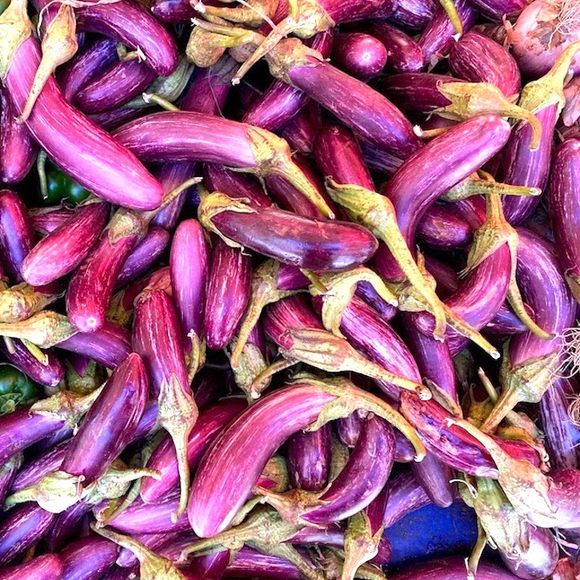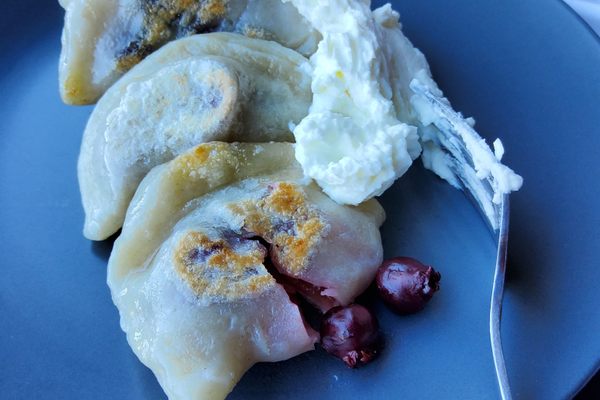Slender and shiny with white stripes, the Tsakoniki melitzana (eggplant) grows only in the valley of Leonidio, a beautiful town in the Peloponnese overlooking the Aegean sea.
Leonidio was once the capital of the Tsakonia region (from which the eggplant gets its name), which consists of several villages where one of the world’s oldest languages—an ancient Greek dialect dating back to the time of King Leonidas of Sparta—is still spoken.
Unlike the dark purple eggplants with which most people are familiar, the Tsakoniki melitzana is slim; it grows to about 20 to 25 centimeters long and 4 to 6 centimeters in diameter. In addition to its trademark white stripes and horn-like end, it is also much sweeter and is used in a variety of summer dishes and sweets in Greece.
According to Maria Lysikatou, president of the Tsakonian Women’s Cooperative of Leonidio, several eggplant varieties have started appearing over the last few years that look like the Tsakoniki but are not. The telltale signs of the Tsakoniki are the sharp end, the white stripes blending into the purple, and the glossy sheen, she says.
According to Lysikatou, the famous Greek eggplant is known for its milder, sweeter taste, “nurtured” by Leonidio’s microclimate and soil, as the village is situated between the sea and massive red limestone cliffs.
In 1996, the European Union granted the Greek eggplant variety PDO (protected designation of origin) certification. As such, it is one of the Tsakonia area’s prime products, generating income for hundreds of farmers in and around Leonidio.
“For us and the region, the Tsakoniki melitzana is our pride and joy,” says Lysikatou. “It promotes our homeland and is part of our heritage, with secrets and recipes passed on from one generation to the next.”
This perennial is picked in June and July, says Lysikatou, and again from September to November. The reason for the month-long break in between, she adds, is that the eggplant doesn’t develop well in excessive heat, cold, or humidity. Picking it in August, the hottest month of the year, may result in brown markings on the skin.
Additionally, unlike the darker Solanum melongena eggplant, which requires soaking in water to remove the bitterness before cooking, the Tsakoniki melitzana does not. This lack of bitterness makes it ideal for use in sweets. The Tsakonia region’s most celebrated sweet is the melitzanaki, which literally means “small eggplant.” The traditional dessert is made into a “spoon sweet,” which is a preserved fruit or vegetable in syrup served on a spoon.
It may seem simple to the eye, but making the melitzanaki spoon sweet requires mastery and perfect timing. In order to make the ultimate sweet, Lysikatou says, the eggplant must be picked prematurely when it is still small and green, then peeled and prepared.
Another great way to prepare the Greek eggplant is to fry it, says Lysikatou. It’s also cooked as part of a vegan stew or with meat (grilled or barbecued), as a dip, in sandwiches, on pizza, and as part of the beloved papoutsaki, stuffed with ground beef and topped with béchamel sauce.
Where to Try It
-
Melitzazz Festival Website
Leonidio , 22300, GreeceEvery July, Leonidio hosts the Melitzazz Festival, which features the Tsakoniki melitzana. Dozens of chefs, pastry makers, and the local women’s cooperative prepare the vegetable in a variety of dishes and sweets.
Written By
M Maria ParavantesSources
- www.visitgreece.gr/mainland/peloponnese/leonidio/#:~:text=It's%20the%20Tsakonian%20language%2C%20which,2%2C000%20people%20in%20this%20area.&text=go%20on%20half%2Dday%20excursions,village%20of%20Aghios%20Vassilios%20(St.
- www.csmonitor.com/World/Making-a-difference/2016/0818/How-a-headmaster-is-trying-to-save-an-ancient-language
- www.qualigeo.eu/en/product/tsakoniki-melitzana-leonidiou-pdo/















